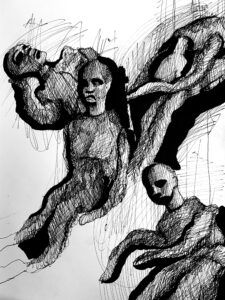The process of making the mannequin was challenging and tedious. The first aspect of this installation that I needed to figure out was what the sculpture would be stuffed with. This material had to be cheap and easily moldable. I chose toilet paper, because volume-wise it is the cheapest of any household item. When tights get stuffed with it, they gain a disconcerting and repulsive appearance, bringing to mind an intestine or an earthworm.
I used three pairs of tights sewn together to create a human-like torso and limbs. The finished doll-like mannequin could be easily adjusted to my desired pose. My main inspiration during this project has been Sarah Lucas’s sculpture Realidad of 2012. The pose of the doll indicates negative emotions that the doll is supposedly feeling. I want to achieve a similar effect, but a big part of this project has been not only making the sculpture evoke feelings of empathy, but photographing it in a way that multiplies the amount of these emotions.
Due to the coronavirus, my installation cannot be displayed as usual, so I have to take into account how I will capture my sculpture using photography. I plan to take a series of photos using a traditional camera. But the final and most important photos of my artwork are going to be taken with an instant camera. There is something special about holding a physical photo as opposed to a digital one on your device. Polaroid photos are often associated with photos taken a long time ago and they trigger distant memories. There is a special saddening quality to Polaroid photos. Whenever I look at such pictures, I have a gut feeling of nostalgia and sadness. This characteristic of instant photography will bring out and strengthen the emotions of empathy and pity that I try to evoke with my art installation. The blemishes and overexposed qualities of Polaroid photos give the scene an eerie, melancholy feeling.
My inspiration for using Polaroids was Walker Evans, one of the most famous American photographers, and his series Polaroids of Women. Evans’s photos were taken particularly close to the subjects. Several of the women in his photos are looking directly at the viewer, but their gaze is blank and lifeless. The yellowish tint on the photos creates the impression of a veil placed over the camera’s lens while the photo is being taken.
Before going out to take photographs of my installation, I need to decide on different possible settings that would ameliorate the sadness and misery of the scene. I plan on taking the photos during the night, so I have to take into account different light sources. After creating the mannequin I decided to familiarize myself with the form by making different observational sketches. I arranged my sculpture in different poses and then tried out several lighting options.
Language in art is a very powerful tool when used properly. It can either bring out the message that is conveyed by the piece or change it completely, even if only one singular word is used. I decided that I wanted to incorporate this technique into this installation, by gluing the word “vulnerable” with pink wool across the mannequin’s chest. This hopefully will make the viewer relate to it in some emotional way and force him or her into feeling empathetic towards the lifeless doll.



